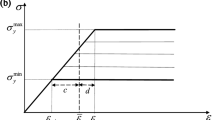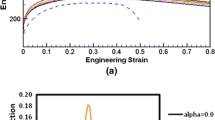Abstract
The randomness of microstructure heterogeneous materials leads to creation of microscopic random stress fields within the bulk of the material under loading. Although in average the microscopic stresses coincide with the macroscopic (e.g., externally applied) stress, the local differences (stress fluctuations) can be high, the magnitude increasing with the volume of the heterogeneous material. In the case of uniform macroscopic loading, Gaussian stress fluctuations lead to a size effect in which the tensile strength reduces as square root of logarithm of the sample size. In practice, however, the macroscopic tensile stress fields are usually nonuniform. In this case, failure is determined by the maximum value of the macroscopic stress with the scale effect controlled by the minimum degree of the macroscopic stress decrease from its maximum. Therefore, a second model is proposed which accounts for a linear stress variation. Comparison of both models with the experimental data on macroscopic strength and stress variations in dog-bone shaped samples (scale range of 1:32), shows that the model based on the assumption of uniform macroscopic stresses can only explain part of the experimental data with unrealistic values of the fitting parameters. The model which takes into account the linear part of the macroscopic stress distribution offers reasonably good accuracy. This serves as another indication that macroscopic stress nonuniformity plays a crucial role in the mechanism of size effect.
Similar content being viewed by others
References
Bazant, Z.P. (1984). Size effect in blunt fracture: Concrete, rock, metal. Journal of Engineering Mechanics 110, 518-535.
Bazant, Z.P. (1993). Scaling laws in mechanics of failure. Journal of Engineering Mechanics 119(9).
Bazant, Z.P. (1997). Scaling of quasibrittle fracture: Hypotheses of invasive and lacunar fractality, their critique and Weibull connection. International Journal of Fracture 83, 41-65.
Carpinteri, A. (1994a). Fractal nature of material microstructure and size effects on apparent mechanical properties. Mechanics of Materials 18, 89-101.
Carpinteri, A. (1994b). Scaling laws and renormalization groups for strength and toughness of disordered materials. International Journal of Solids and Structures 31(3), 291-302.
Carpinteri, A., Chiaia, B. and Ferro, G. (1994). Multifractal scaling laws for the nominal strength variation in concrete structures. Size Effect in Concrete Structures (Proceedings, Japan Concrete Institute International Workshop, Sendai, Japan, 1993), 173-185.
Cherepanov, G.P. (1979). Mechanics of Brittle Fracture, New York, McGraw-Hill.
Cherepanov, G.P. (1997). Methods of Fracture Mechanics: Solid Matter Physics. Kluwer Academic Publishers, Dordrecht, Boston, London.
David, H.A. (1970). Order Statistics. John Wiley & Sons, Inc. New York, London.
Dyskin, A.V. (1997). Crack growth under spatially random stress fields. Advances in Fracture Research, Proceedings of 9th International Conference on Fracture 4, 2119-2126.
Dyskin, A.V. (1998). On the role of stress fluctuations in brittle fracture. International Journal of Fracture (in print).
Dyskin, A.V. and Germanovich, L.N. (1993). A model of crack growth in microcracked rock. International Journal of Rock Mechanics and Mining Sciences and Geomechanics Abstracts. 30(7), 813-820.
Freudenthal A.D. (1968). Statistical approach to brittle fracture. Fracture, An Advanced Treatise (Edited by H. Liebowitz), 2, 591-619.
Galambos, J. (1978). The Asymptotic Theory of Extreme Order Statistics. John Wiley & Sons.
Germanovich, L.N., Salganik, R.L., Dyskin A.V. and Lee, K.K. (1994). Mechanisms of brittle fracture of rock with multiple pre-existing cracks in compression. Pure and Applied Geophysics (PAGEOPH) 143(1/2/3), 117-149.
Jaeger, J.A. (1979). Rock Mechanics and Engineering. Cambridge University Press, Cambridge.
Kunin, I.A. (1983). Elastic media with microstructure, Vol. 2. Three-Dimensional Models, Springer Series in Solid-State Sciences (44).
Mori, T. and Tanaka, K. (1973). Average stress in matrix and average elastic energy of materials with misfitting inclusions. Acta Metallurgica 21, 571-574.
Ortiz, M. and Suresh, S. (1993). Statistical properties of residual stresses and intergranular fracture in ceramic materials. Journal of Applied Mechanics 60, 77-84.
Takayasu, H. (1990). Fractals in the Physical Sciences, John Wiley & Sons.
Turcotte, D.L. (1992). Fractals and Chaos in Geology and Geophysics, Cambridge University Press, Cambridge.
Van Vliet, M.R.A.(2000). Size effect in tensile fracture of concrete and rock, PhD thesis, Delft University of Technology.
Van Vliet, M.R.A. and Van Mier, J.G.M. (1997). Concrete behaviour under uniaxial tension: Effect of casting and drying conditions. Brittle Matrix Composites (Edited by A. Brandt, V. Li and I. Marshall) 5, 329-339.
Van Vliet, M.R.A. and Van Mier, J.G.M. (1998). Experimental and numerical investigation of size scale effects in concrete fracture. Material Instabilities in Solids (Edited by R. de Borst and E. van der Giessen), John Wiley & Sons Ltd, 185-206.
Van Vliet, M.R.A. and Van Mier, J.G.M. (1999). Effect of strain gradients on the size effect of concrete in uniaxial tension. International Journal of Fracture 95(1/4), 195-219.
Author information
Authors and Affiliations
Rights and permissions
About this article
Cite this article
Dyskin, A.V., Vliet, M.R.V. & Mier, J.G.V. Size effect in tensile strength caused by stress fluctuations. International Journal of Fracture 108, 43–61 (2001). https://doi.org/10.1023/A:1007665018241
Issue Date:
DOI: https://doi.org/10.1023/A:1007665018241




